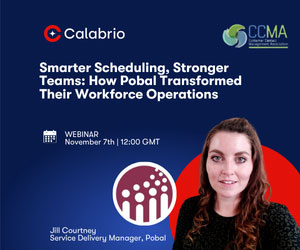Chris Dealy looks at the biggest mistakes made in scheduling.
1. Failing to use flexible scheduling
The most basic forms of agent scheduling are fixed shifts and simple rotating patterns. For example, week one early, week two middle of day, week three late, repeat. Fixed schedules can be managed with spreadsheets, and agents welcome predictable working times. In some centres, flexible scheduling is regarded as a bad thing.
In reality, flexibility is far from bad. From the point of view of schedule efficiency, cost saving and customer service, the more flexibility you have, the better. In many centres, agent contracts allow the start times and finish times to be varied so that each agent’s working hours are optimised, yet planners and managers sometimes baulk at doing this.
Flexible scheduling lets you match ‘demand’ (workload) with ‘supply’ (on-duty agents) as it allows more granular assignment of start times, finish times and breaks.
Here’s an example: The period from 09:00 to 09:15 is over-staffed and the period from 09:15 to 09:30 is understaffed.
If you simply delay the start time of one agent by 15 minutes you will improve schedule efficiency and get closer to service level goals in two intervals.
2. Not properly handling shrinkage
Staff shrinkage is the paid time, typically unscheduled, that employees are not available to handle contacts. This includes activities such as breaks, meetings, and training, plus out-of-office time for holidays, sickness, and unexplained absences.
Staff shrinkage is an important number to track as it relates to how many people need to be scheduled in each interval. If you don’t factor in shrinkage when calculating how many staff to schedule, you will always be understaffed.
You can get data for calculating shrinkage from attendance reports and workforce management (WFM) systems. The formula is pretty straightforward, although there are some pitfalls to watch out for.
For example, shrinkage is not a constant; it varies over time, such as during the summer holidays, when it will be higher. It can also vary by day and by week. Make sure that you use the most appropriate shrinkage estimate before scheduling staff.
It’s also important to get the calculation right. In an interval where 70 employees must be on duty in order to meet the service level, and shrinkage is 30%, you should schedule 70 / (1-0.3) = 100 people. If you add 30% to 70, the result is 91, which is insufficient.
You mustn’t think that shrinkage is beyond your control. As the old saying goes, if you can’t measure it, you can’t manage it. But if you track shrinkage factors – and if employees know that you are tracking shrinkage factors – you can minimise them.
3. Employing too few part-timers and short shifts
Most call centres experience peaks and troughs in workload by time of day, with many experiencing the classic ‘M curve’; one peak in the morning and another in the afternoon.
But if all of your agents work full time you will always struggle to avoid unders and overs. A four-hour peak window can’t be addressed by moving hours from elsewhere in the schedule, and bringing in more full-timers causes over-staffing.
It helps if you can schedule breaks to take place during troughs in demand but this is unlikely to completely solve the problem. Split shifts can be useful but are not liked by agents. In a normal operation, a workforce that is exclusively full time will be inefficient.
Part-timers make it easier to cover peak hours and thus enable better workload fit. They don’t need a lunch break. Tools and techniques exist to make the scheduling of part-timers easier. Part-timers stay fresh for their whole shift simply because it is shorter.
It’s a mistake to assume that all agents are looking for full-time work. Parents, students and carers actively prefer part-time working since it gives them the work/life balance that they need.
It’s not necessary to have your entire workforce on part-time contracts to get good workload fit. There is usually an ideal mix which varies from centre to centre, with 25 to 30% part-timers being a common rule of thumb.
4. Not scheduling breaks
Even if your contractual landscape prevents flexible schedules, you should still consider scheduling breaks. This one step can make a huge difference to efficiency and service level and it is normally less challenging from a contractual point of view.
If your agents currently take breaks when they feel like it, and groups of friends go to lunch at the same time, a culture shift will be needed. You may need to give something in return for the scheduling of breaks.
This needn’t be money – it could be giving agents some sort of online self-service portal to book holidays, for example.
5. Not measuring schedule efficiency properly
The call centre is a data-rich environment. You can get all sorts of reports and key performance indicators (KPIs), common ones being service level, first contact resolution (FCR), calls answered, calls abandoned and agent occupancy. It is definitely a good idea to make schedule efficiency one of your KPIs, since it affects almost all the other metrics.
Schedule efficiency is a measure of how accurately and consistently the planned number of ‘bums on seats’ matches the required staffing over the evaluation period. Deltas between planned and required should be measured in 15- or 30-minute intervals and summarised on a weekly or monthly basis to produce a score.
It should be possible to get a clear picture of schedule efficiency from your WFM tool or, if you are using spreadsheets, by using the Standard Deviation or Correlation Coefficient functions. Make sure that you use weighted averages when producing consolidated figures; 50% coverage is a much bigger problem in an interval with 100 calls than in one with 10.
And don’t forget to exclude time outside business hours.
To reach 100% efficiency is impossible in the real world. Keeping track of your schedule efficiency and benchmarking it over time – and ideally with your industry peers – is a must-do.
6. Obsessing about overtime
If you are planning well, overtime will rarely be required. Nonetheless, optimal shifts, which minimise over- and under-staffing at all times can only be achieved by asking some team members to work overtime. But paying overtime is expensive and intrinsically evil, right? Not necessarily.
Fully loaded hourly labour cost is calculated from four components: Base pay, Employer National Insurance, other overheads and the pay ratio. Although overtime attracts a premium, National Insurance and allowance for holidays are already absorbed in normal time and are not paid on overtime.
So, in reality, the fully loaded cost of overtime is little higher than normal time. On the other hand, if you produce schedules which lead to periods of over-staffing, then one or more agents will be paid the normal hourly rate to add no value.
Studies have shown that idle time has a far greater adverse cost than overtime. This may offend common sense, but the fact remains that overtime should be part of a well-run call centre. Excessive use of overtime is clearly a sign of poor planning but it should not be avoided on dogmatic grounds.
7. Assuming nobody wants to work unsocial hours
Many planners believe that it will be a challenge to fill ‘unsocial’ shifts like evenings, weekends and bank holidays. While the stereotypical call centre agent would rather be in the pub on a Friday night, this is not necessarily the case for everyone. Some people actually relish working evenings and weekends.
The classic case is students, who often prefer to work evenings and weekends, and other groups like this.
In reality, unsocial hours tend to be low workload hours and the scope of the problem is correspondingly smaller.
8. Trying to muddle through
It is never a good idea in life to just hope for the best.
Here is a story from a planner at a major US retail call centre, who wishes to remain nameless:

Chris Dealy
“We had suffered an unexpectedly high level of staff attrition and as peak season began, we became consistently under-staffed. It takes time to train up new hires – typically four weeks. Plus we had recently changed our recruiting provider, introducing uncertainty. We decided to muddle through without hiring. We figured that this would avoid recruitment costs and the need to lay off the new starters when peak season came to an end. I recommended keeping on under-performing agents, one of whom was on final warning, to make the numbers add up. Big mistake! The agents set a bad example, encouraging their co-workers to turn up late, take long breaks, etc., so exacerbating the under-staffing problem rather than fixing it.”
The moral of the story: Hope is not a substitute for good planning and taking hard decisions.
With thanks to Chris Dealy at injixo
Author: Megan Jones
Published On: 10th Feb 2016 - Last modified: 17th Jun 2024
Read more about - Archived Content, Chris Dealy, Peopleware, Scheduling































Thanks for this article. Very informative. You mentioned 25 to 30% part-timers as being a common rule of thumb. How do you I come up with what part-time levels to implement at my organization. I need to prove to management that 15% for example is what we need to implement as opposed to say 30%.
What is your take on this?
Thanks
Robert
Hi Robert. It is only a rule of thumb. You will need to do a match of call arrival patterns against numbers of staff to find the optimum figure. Most people that I know do this on an Excel sheet for planning purposes. You may find that 15% is the right answer for you. The key is to look at how you can best staff the busy periods and the quieter periods.